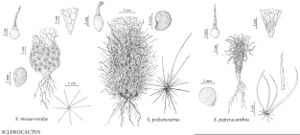Sclerocactus papyracanthus
Bradleya 5: 94. 1987.
Stems unbranched, cylindric or obconic cylindric, 2–7.5 (–8) × 1.2–2.5 cm; ribs not evident, tubercles prominent. Spines dense, obscuring stems; radial spines 5–10 per areole, white, straight, flat, (2–) 3–5 × 0.3–0.6 mm; central spines 1 (–4) per areole; abaxial central spine 1 per areole, whitish to tan or gray, straight, wavy, twisting, or curling, flat, flexible, papery, with obscure adaxial midrib, sometimes pointing upward and obscuring apex of plant, lacking hook, 15–45 (–50) × 1–1.5 mm; lateral or adaxial central spines 0 (–3) per areole, white to tan, (3–) 20–40 × 0.5–1 mm. Flowers funnelform to narrowly campanulate, 2–2.5 × 1–2.5 cm; outer tepals with green-purple to redbrown midstripes and cream to white margins, cuneate-spatulate, usually 9–20 × 1–3 mm, finely toothed; inner tepals white with brown midstripes, largest tepals oblanceolate, 15–20 × 3.5–4.5 mm, apex acute to mucronate; filaments white to greenish yellow; anthers cream to pale-yellow. Fruits indehiscent or irregularly dehiscent, green, subspheric, 4–6 × 3–5 mm, dry at maturity; scales few or none. Seeds black, 2.5–3 × 2–2.5 mm, shiny; testa with fine, rounded papillae.
Habitat: Desert grasslands, pinyon-juniper woodlands, Chihuahuan desert scrub
Elevation: 1500-2200 m
Distribution

Ariz., N.Mex., Tex.
Discussion
With long, flexuous, flattened spines and pale flowers, Sclerocactus papyracanthus is surprisingly cryptic in the field. There has been a long debate concerning its taxonomic placement. Chloroplast DNA analyses of J. M. Porter et al. (2000) unambiguously placed this species within Sclerocactus, a position first suggested based on morphologic evidence (K. D. Heil et al. 1981; C. Glass and R. A. Foster 1984).
Selected References
None.
